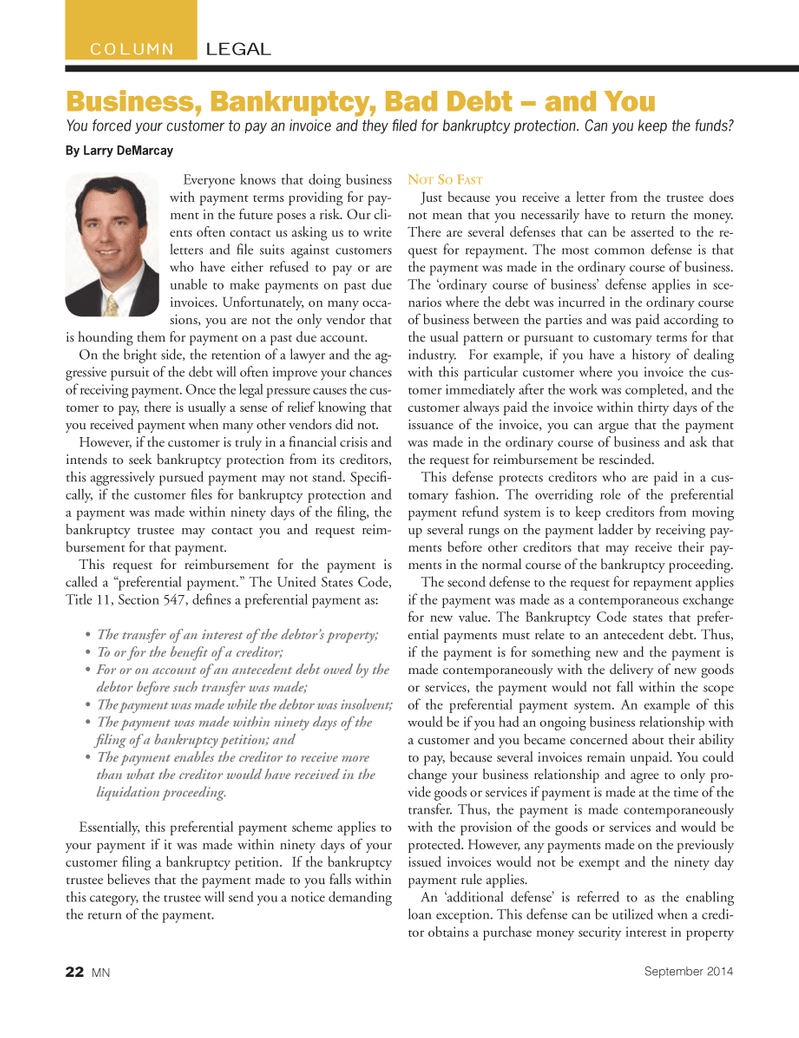
Page 22: of Marine News Magazine (September 2014)
Inland Waterways
Read this page in Pdf, Flash or Html5 edition of September 2014 Marine News Magazine
Everyone knows that doing business with payment terms providing for pay- ment in the future poses a risk. Our cli- ents often contact us asking us to write letters and Þ le suits against customers who have either refused to pay or are unable to make payments on past due invoices. Unfortunately, on many occa- sions, you are not the only vendor that is hounding them for payment on a past due account. On the bright side, the retention of a lawyer and the ag- gressive pursuit of the debt will often improve your chances of receiving payment. Once the legal pressure causes the cus- tomer to pay, there is usually a sense of relief knowing that you received payment when many other vendors did not. However, if the customer is truly in a Þ nancial crisis and intends to seek bankruptcy protection from its creditors, this aggressively pursued payment may not stand. SpeciÞ -cally, if the customer Þ les for bankruptcy protection and a payment was made within ninety days of the Þ ling, the bankruptcy trustee may contact you and request reim- bursement for that payment. This request for reimbursement for the payment is called a Òpreferential payment.Ó The United States Code, Title 11, Section 547, deÞ nes a preferential payment as: The transfer of an interest of the debtor?s property; To or for the bene t of a creditor; For or on account of an antecedent debt owed by the debtor before such transfer was made; The payment was made while the debtor was insolvent; The payment was made within ninety days of the ling of a bankruptcy petition; and The payment enables the creditor to receive more than what the creditor would have received in the liquidation proceeding. Essentially, this preferential payment scheme applies to your payment if it was made within ninety days of your customer Þ ling a bankruptcy petition. If the bankruptcy trustee believes that the payment made to you falls within this category, the trustee will send you a notice demanding the return of the payment. NOT SO FASTJust because you receive a letter from the trustee does not mean that you necessarily have to return the money. There are several defenses that can be asserted to the re- quest for repayment. The most common defense is that the payment was made in the ordinary course of business. The Ôordinary course of businessÕ defense applies in sce- narios where the debt was incurred in the ordinary course of business between the parties and was paid according to the usual pattern or pursuant to customary terms for that industry. For example, if you have a history of dealing with this particular customer where you invoice the cus- tomer immediately after the work was completed, and the customer always paid the invoice within thirty days of the issuance of the invoice, you can argue that the payment was made in the ordinary course of business and ask that the request for reimbursement be rescinded. This defense protects creditors who are paid in a cus- tomary fashion. The overriding role of the preferential payment refund system is to keep creditors from moving up several rungs on the payment ladder by receiving pay- ments before other creditors that may receive their pay- ments in the normal course of the bankruptcy proceeding. The second defense to the request for repayment applies if the payment was made as a contemporaneous exchange for new value. The Bankruptcy Code states that prefer- ential payments must relate to an antecedent debt. Thus, if the payment is for something new and the payment is made contemporaneously with the delivery of new goods or services, the payment would not fall within the scope of the preferential payment system. An example of this would be if you had an ongoing business relationship with a customer and you became concerned about their ability to pay, because several invoices remain unpaid. You could change your business relationship and agree to only pro- vide goods or services if payment is made at the time of the transfer. Thus, the payment is made contemporaneously with the provision of the goods or services and would be protected. However, any payments made on the previously issued invoices would not be exempt and the ninety day payment rule applies. An Ôadditional defenseÕ is referred to as the enabling loan exception. This defense can be utilized when a credi- tor obtains a purchase money security interest in property LEGALCOLUMNBusiness, Bankruptcy, Bad Debt ? and You You forced your customer to pay an invoice and they Þ led for bankruptcy protection. Can you keep the funds? By Larry DeMarcay 22 MNSeptember 2014MN Sept14 Layout 18-31.indd 22MN Sept14 Layout 18-31.indd 228/20/2014 11:43:29 AM8/20/2014 11:43:29 AM

 21
21

 23
23
